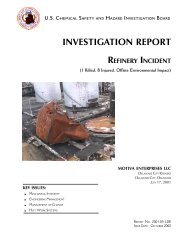CTA Report, Draft 1, ISP Review - US Chemical Safety and Hazard ...
CTA Report, Draft 1, ISP Review - US Chemical Safety and Hazard ...
CTA Report, Draft 1, ISP Review - US Chemical Safety and Hazard ...
Create successful ePaper yourself
Turn your PDF publications into a flip-book with our unique Google optimized e-Paper software.
APPENDIX D: NFPA Guidelines<br />
In promoting the science <strong>and</strong> improving the methods of fire protection <strong>and</strong> prevention, NFPA develops<br />
codes <strong>and</strong> st<strong>and</strong>ards to reduce the loss of life, property, <strong>and</strong> production. Table D-1 lists NFPA st<strong>and</strong>ards<br />
relevant to controlling dust explosion hazards.<br />
Although NFPA st<strong>and</strong>ards are advisory only, they are widely adopted by regulatory government agencies<br />
such as OSHA <strong>and</strong> state <strong>and</strong> local public authorities. Upon request, NFPA provides training <strong>and</strong> ongoing<br />
technical support to Federal, state, <strong>and</strong> local authorities that have adopted its codes <strong>and</strong> st<strong>and</strong>ards.<br />
D.1 NFPA 654<br />
NFPA 654, Prevention of Fire <strong>and</strong> Dust Explosions From the Manufacturing, Processing, <strong>and</strong> H<strong>and</strong>ling<br />
of Combustible Particulate Solids (2000), addresses dust explosion prevention <strong>and</strong> mitigation for<br />
industrial facilities such as <strong>CTA</strong>. It was developed in 1943 <strong>and</strong> originally applied only to the prevention<br />
of dust explosions in the plastics industry. In 1976, NFPA exp<strong>and</strong>ed the scope of the st<strong>and</strong>ard to include<br />
chemical, dye, <strong>and</strong> pharmaceutical dusts, but a new edition of the st<strong>and</strong>ard was not issued until 1982. The<br />
st<strong>and</strong>ard was revised again in 1997 to include all industries where manufacture, processing, blending,<br />
repackaging, <strong>and</strong> h<strong>and</strong>ling of combustible dusts presented a fire or explosion hazard. NFPA 654<br />
addresses safe design <strong>and</strong> construction, management of change, <strong>and</strong> housekeeping for facilities that<br />
h<strong>and</strong>le combustible dusts—specifying that “areas in which combustible dusts are produced, processed,<br />
h<strong>and</strong>led, or collected shall be detached, segregated, or separated from other occupancies in order to<br />
minimize damage from a fire or explosion.” 28<br />
28 NFPA 654 defines segregation as the interposing of a fire- <strong>and</strong> explosion-resistant barrier between the<br />
combustible particulate solid process <strong>and</strong> other operations. Separation is defined as the interposing of distance<br />
between the combustible particulate solid process <strong>and</strong> other operations in the same room.<br />
117









